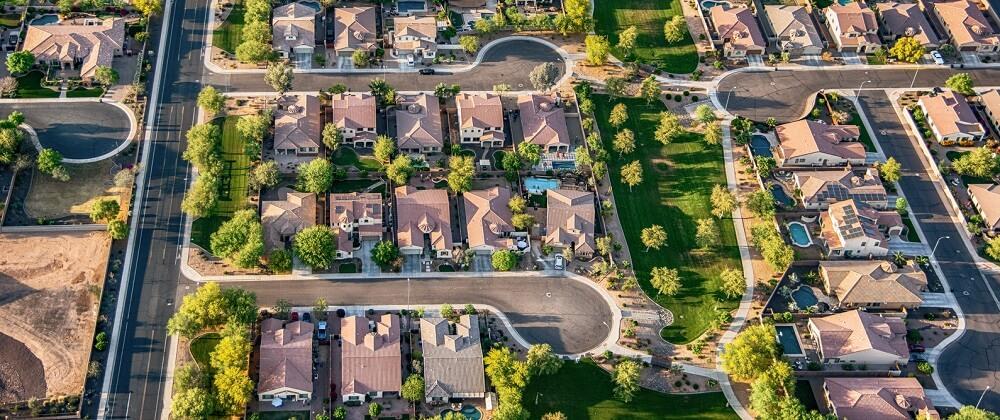
What Are Planned Communities? History, Pros & Cons, Examples
By: ROS Team
Ever dreamed of a neighborhood designed just for you? Planned communities offer a different kind of living experience, with everything from parks and pools to specific architectural styles. But are they right for everyone? In this blog, we’ll dive into the world of planned communities, exploring their history, pros & cons, and some real-life examples.
What Is a Planned Community?
A planned community refers to a large suburban housing development spanning approximately 2,500 acres. Commonly found near major cities in southern and coastal states like Texas, Florida, and California these communities integrate residential areas with commercial spaces and recreational facilities. Careful planning ensures cohesive infrastructure, amenities, and landscaping, creating an appealing living environment.
History of Planned Communities
Riverside, created in 1869 near Chicago, was the first planned community in the United States.. It was designed by Frederick Law Olmsted and Calvert Vaux. After Riverside’s success, many planned communities emerged across America, especially in California, Florida, Texas, and the Intermountain West.

These communities often cater to specific interests or lifestyles. For example, Siena in Round Rock, TX focuses on outdoor activities. It has hiking and biking trails, parks, and a communal pool. Bald Head Island, NC offers a coastal lifestyle. It has unique features like maritime forests and a yacht club.
Other communities provide amenities like water parks, velodromes, and zip lines. These are tailored to diverse preferences and desires of the residents.
Is a Planned Community Same as a Traditional Community?
Nope! Planned communities are designed all at once with amenities in mind, while traditional communities develop more organically, with houses built and businesses popping up over time.
Benefits of Planned Communities
A Sense of Community:
Planned neighborhoods foster strong connections among residents. Shared areas encourage socializing. Organized events bring people together, cultivating a spirit of belonging.
Safety and Security:
These communities prioritize resident safety. Security measures like gates, patrols, and surveillance systems create a secure environment, promoting peace of mind.
Green Spaces:
Abundant natural areas, including parks, trails, and landscaping, are integral. These spaces facilitate outdoor recreation and closeness to nature within the neighborhood.
Amenities:
Residents of planned neighborhoods enjoy access to a variety of amenities, such as pools, fitness centers, playgrounds, and community hubs. These enhances the quality of life by providing leisure options close to home.
Less Traffic and Clever Road Planning:
Careful road planning and traffic management strategies in planned neighborhood help minimize congestion and improve traffic flow, creating safer and more efficient transportation networks for residents.
Flexibility in Home Choices:
Planned communities offer diverse housing options, including single-family homes, townhouses, apartments, and condos. This caters to various lifestyles, preferences, and budgets, accommodating diverse residents.
Consistent Architectural Style and Appearance:
Following cohesive architectural principles and consistent design guidelines ensures these communities exhibit a visually harmonious and appealing aesthetic throughout. This unified appearance enhances property values and cultivates an attractive residential environment.
Downsides of Planned Communities
Extra Fees:
Planned communities often entail additional fees, with a typical premium in housing costs averaging around 6%. These fees cover the maintenance of communal amenities and infrastructure, potentially adding to the overall cost of living in these areas.
Less Privacy:
Due to the closely-knit nature of planned communities, residents may experience a reduction in privacy compared to living in more isolated or less densely populated areas. Shared spaces, communal facilities, and close proximity to neighbors can lead to a higher degree of visibility and interaction.
Community Development District (CDD):
Many planned communities are managed by Community Development Districts (CDDs), akin to homeowners associations (HOAs) but potentially with more stringent regulations. CDDs may impose additional rules and restrictions on residents’ behavior, property appearance, and usage of communal spaces, potentially limiting individual freedoms within the community.
What Is an Example of a Planned Community?
Some famous examples of a planned community are:
- Skye Canyon (Las Vegas, NV)
- Meridian Ranch (Falcon, CO)
- The Rivers (West Sacramento, CA)
- Overland Grove (Forney, TX)
What Is the Largest Planned Community in the United States?
The title of largest planned community in the United States goes to The Woodlands, Texas, spanning a whopping 44.5 square miles and boasting over 120,000 residents.
What Is a Master Planned Community?
Master planned communities are essentially amplified planned communities. Designed from scratch, they’re large-scale developments with housing, shops, entertainment, and sometimes even schools all within the community, offering a self-contained feel with a focus on convenience and amenities.
Is a Planned Community Right for You?
A planned community can be a great fit if you crave a sense of community, security, and convenient amenities. But if you value complete design freedom or a more diverse, organic environment, it might not be the best choice.








